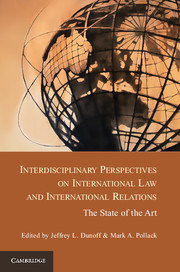 Interdisciplinary Perspectives on International Law and International Relations
Interdisciplinary Perspectives on International Law and International Relations Book contents
- Frontmatter
- Contents
- Contributors
- Acknowledgments
- Part I Introduction: Setting the Stage
- 1 International Law and International Relations
- 2 Law, Legalization, and Politics
- Part II Theorizing International Law
- Part III Making International Law
- Part IV The Interpretation and Application of International Law
- Part V Enforcement, Compliance, and Effectiveness
- Conclusions
- Index
- References
1 - International Law and International Relations
Introducing an Interdisciplinary Dialogue
Published online by Cambridge University Press: 05 January 2013
- Frontmatter
- Contents
- Contributors
- Acknowledgments
- Part I Introduction: Setting the Stage
- 1 International Law and International Relations
- 2 Law, Legalization, and Politics
- Part II Theorizing International Law
- Part III Making International Law
- Part IV The Interpretation and Application of International Law
- Part V Enforcement, Compliance, and Effectiveness
- Conclusions
- Index
- References
Summary
A casual observer might expect that international lawyers and international relations scholars would share overlapping research interests and scholarly agendas. In fact, for several decades prior to the Second World War, practitioners in both fields pursued common interests in the making, interpretation, and enforcement of international law. As a matter of disciplinary history, however, World War II served as a watershed event, largely discrediting international law among political scientists as “realist” theorists rejected the notion that international law could serve as a meaningful constraint on states’ pursuit of the national interest. Over the next four decades, international relations (IR) and international law (IL) scholarship developed along separate and rarely intersecting tracks. Legal scholars sought to emphasize law's autonomy from politics, and focused on identifying, criticizing, or justifying specific legal rules and decision-making processes. For their part, political scientists seldom referenced international law as such, even when their topics of interest, such as international cooperation and international regimes, overlapped in clear ways with international law.
The mutual neglect among international law and politics began to ebb only with the end of the Cold War and the increased salience of international rules and institutions. In 1989, legal scholar Kenneth Abbott published a manifesto calling for interdisciplinary scholarship on international law and encouraging legal scholars to draw upon recent political science scholarship. Over the next decade, a growing number of legal scholars began to ask new questions about the design and workings of international law, drawing on both theories of international relations and on qualitative and quantitative methods imported from political science. By the early 2000s, political scientists in turn “rediscovered” international law, a development marked most clearly by the publication of a special issue of International Organization, the leading journal in the field, devoted to understanding the causes and consequences of the “legalization” of international politics.
- Type
- Chapter
- Information
- Interdisciplinary Perspectives on International Law and International RelationsThe State of the Art, pp. 3 - 32Publisher: Cambridge University PressPrint publication year: 2012
References
- 18
- Cited by


